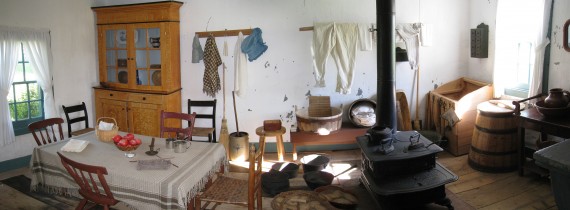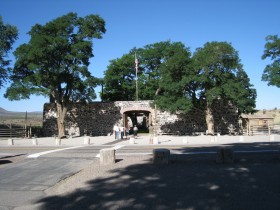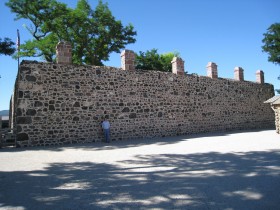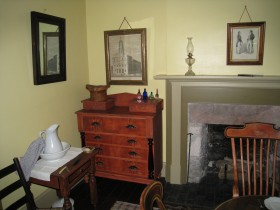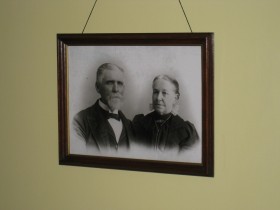While in southern Utah, Jill and I visited the Utah Shakespearean Festival, Mountain Meadow Monument, and Old Iron Town. On our way home we visited Cove Fort. Click on the images to enlarge.
Cove Fort
Cove Fort is located on Cove Creek a mile northeast of the I-15 and I-70 junction in Millard County, Utah. It was founded on 29 April 1867 by Ira Hinckley at the request of Brigham Young. Ira Nathaniel Hinckley is the paternal grandfather of Gordon B. Hinckley. Other workmen were called to the site, including Ira’s brother, Arza Erastus Hinckley. The fort is made of volcanic rock and dark limestone, rather than the wood used in many mid-19th century western forts. Lumber, mostly cedar and pine, was used for the roof, twelve interior rooms, six on the north and six on the south, and the massive doors at the east and west ends of the fort. The fort is 100 feet square, 18.5 feet tall, 4 feet thick at the footings, and 2.5 feet thick at the top.The site for Cove Fort was selected by Brigham Young because of its location approximately half way between Fillmore, then the capitol of the Utah Territory, and the nearest city, Beaver. It is the only fort built by the Latter-day Saints in the 19th century that still stands.
Safe Shelter
It provided a way station for people traveling the Mormon Corridor. The abandonment of Fort Willden in 1865 left travelers without shelter from hostile Indians during the Black Hawk War or from severe weather conditions. In addition, it was also necessary to afford safety to carriers of the U.S. mail, operators of the Deseret Telegraph, agents of the stagecoach line, and freighters.A town would have been constructed at the Cove Fort site, but the water supply was inadequate to support a sizable population. Another key factor in the selection of the site was the prior existence of a wooden-palisade fort, Willden Fort, which provided shelter and safety for the work crews who constructed Cove Fort. Willden Fort was erected by the Charles William Willden family in 1860.
Cove Fort Interior
The fort has two sets of large wooden doors at the east and west ends, originally filled with sand to stop bullets, and contains twelve interior rooms. The six rooms along the south wall were used for business, domestic, and social activities. The last three rooms along the north side of the fort served as a private residence for the Hinckley family.
Postal express riders delivered and picked up mail collected at the fort from nearby residents, ranches, and miners. One mail carrier, William Anderson, would leave Fillmore at 6:00 a.m. on Monday and arrive in Cedar City Wednesday evening near 6:00 p.m. He would average 47 miles a day.
As a daily stop for two stagecoach lines as well as many other travelers, Cove Fort was heavily used for many years, often housing and feeding up to 75 people at a time. In addition to providing a place to rest, a blacksmith/farrier resided at the fort who shod horses and oxen, and also repaired wagon wheels. With its telegraph office and as a Pony Express stop, it also acted as a regional communications hub.
Selling Cove Fort
In the early 1890s, The Church of Jesus Christ of Latter-day Saints determined that the fort was no longer required and leased it out, selling it outright on 21 August 1919 to William Henry Kesler, who had leased the land since 1903. In 1988 the Hinckley family purchased the fort and donated it back to the church. On 9 May 1992* LDS general authority Gordon B. Hinckley dedicated the newly restored fort.
What has been done is a great and significant thing from the point of view of the Church, the state, and the nation. Once forts were found in abundance across this great land. Now there are very few left. Cove Fort is the only one of the pioneer Church forts which still stands in its entirety.
President Hinckley, First Counselor in the First Presidency, at the dedication.
The Church also transported Ira Hinckley’s Coalville, Utah cabin to the site, constructed a visitor center, and reopened the fort as a historic site.
It is our hope that Cove Fort will serve as a modern way station—not as a shelter from physical fatigue or protection from the elements. Rather, we hope it will serve as a spiritual way station where we can be reminded of the faith of our forefathers, where we can refresh our sense of sacrifice and obedience and our dedication to duty, where we can be reminded of the values of work, provident living, self-sufficiency, and family unity.
Elder Stephen D. Nadauld of the Seventy, at the dedication
* I read of two dates for the dedication: 9 May 1992 and 21 May 1994. If you know which of these is correct, please communicate through a comment.
